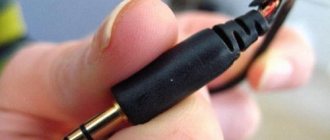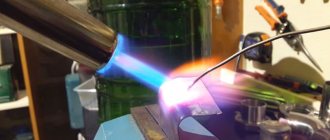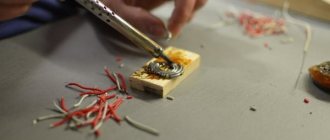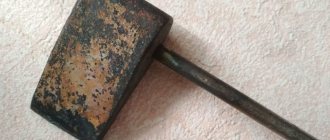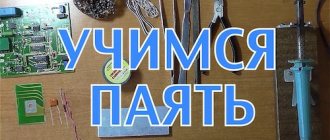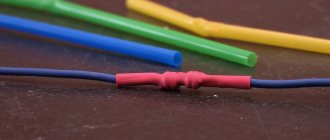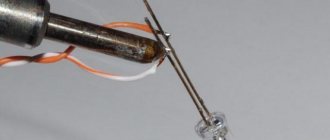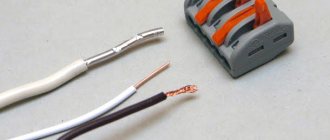How to learn to solder wires correctly
A soldered connection is considered one of the best in terms of reliability in electrical engineering, and in radio engineering, soldering of radio components is indispensable during their installation.
Soldering is the joining of homogeneous and dissimilar metal parts using a metal alloy called solder, which has a melting point lower than the structures being soldered.
Physics of soldering processes
Molten solder behaves like a liquid, one of the properties of which is surface wetting - that is, the distribution of molecules over the surface in a thin layer.
Solder molecules diffuse in the surface layer of the metal, which, in turn, partially dissolves in the solder.
An important role is played by the type of surface and its contamination, as well as the presence of an oxide film.
In short, soldering two wires means moistening their surfaces with a continuous layer of molten solder, which, once hardened, will provide mechanical strength to the connection and reliable electrical contact.
Since copper conductors are used in household electrical wiring, we will mainly talk about how to solder copper.
The process of soldering copper wires is not so demanding in terms of the choice of solder, flux and temperature, so anyone - you need to acquire minimal equipment and follow safety rules.
Soldering tools
A heating device used to heat solder and soldered structures is called a soldering iron.
This is what a soldering iron consists of
Types of soldering irons common in everyday life:
- electric heating.
The heating element heats up the copper tip, the end of which is the working surface of the tool. This type of soldering iron is the most common, therefore, we will tell you how to properly solder wires using this particular tool, with a power of 60-100 W, tip temperature up to 300ºC;
- hot air and gas.Gas burnerThermal air
A stream of hot air or an open flame heats up the soldering area, to which solder is supplied in the form of filler wire.
Due to the high thermal power of these tools, they are used for soldering massive parts that require a lot of heat to heat up;
- hammer
The copper tip is made in the form of a massive hammer, heated by an open flame or a built-in electric heating element.
You can solder without electricity using a hammer soldering iron. Due to the large heat capacity of the tip, with proper skill, the master can solder all the wires in the junction box with one heating.
Selecting consumables
You need to purchase low-temperature tin-lead solder type POS. The number following the abbreviation indicates the percentage composition of tin. The most popular brand in radio electronics and electrical engineering is POS-61 (a foreign analogue of Sn63Pb37) due to the coincidence of the temperatures of the initial and complete melting of the alloy (190ºС).
Solders of other brands have a temperature range in which the alloy is in a specific eutectic state and looks like a paste of fine-grained granules. Light movement of parts in this temperature range significantly impairs the quality of soldering.
POS-61 is not subject to this eutectic effect and passes from the solid phase to the liquid phase and vice versa immediately after reaching a temperature of 190ºC, so for beginners it is best to use this particular brand of solder, which is sold in coils in the form of wire or a tube with rosin. Rosin is most often used as a flux for soldering copper wires.
as well as soldering acid based on zinc chloride - their role will be discussed below.
Wire tinning process
Cleaning surfaces before soldering is the most important step in this process. First you need to remove the insulation from the wires and make sure that there is no enamel coating or oxide film on them.
Stripping copper wires
Cleaning the surface of the conductor to a metallic shine using a knife or finely abrasive sandpaper will help in tinning - this is the name of the process of wetting the solder area with solder. To do this, you need to touch the rosin with the heated tip of the tip - the characteristic hissing and boiling of the flux will indicate the normal temperature of the soldering iron.
Wire tinning
Without delay, so that the rosin does not evaporate, you need to take a drop of solder by touching the unwound POS-61 wiring. In this case, the flux prevents the oxidation of the solder. The second function of rosin or soldering acid is to decompose the oxide film on the metal surface.
Tinning
Tinning is best done by pressing the wire with a soldering iron tip to a wooden plank - the gases released during the pyrolysis of wood also partially help, acting as a flux.
Much better results are achieved using an aspirin tablet as a support. Acetylsalicylic acid, when evaporated, effectively removes the oxide layer.
tinning of twists
The nuances of tinning
Solder is spread over the surface of the wire, rolling it along the axis. If the exposed conductor is not completely tinning, and the rosin stops boiling, then you need to re-tip the flux and POS if necessary.
Soldering wires
Tinning a stranded wire is the same, but it needs to be twisted so that the wires twist and do not unravel. It is often necessary to tin thin stranded wires coated with enamel. Since stripping with a knife is impossible due to the thin veins, the enamel is removed chemically - for this, a piece of polyvinyl chloride insulation is taken as a substrate.
tinning of stranded wires
By placing the wires on the insulation, tinning is carried out - when heated, the PVC releases chlorine, which corrodes the enamel, thereby opening up the access necessary for tinning to the metal surface.
how to solder wires from process to process
Soldering process
In fact, the answer to the question of how to solder correctly will be in one word: tinning, since soldering two tinned wires is not particularly difficult. Since in electrical engineering it is not recommended to solder overlapping wires, they are twisted before soldering.
twisting of stranded wire
Having twisted two or more tinned wires, take rosin and solder again and touch the twist, waiting for the alloy to completely spread between the wires, filling the voids and gaps.
Soldered Copper Stranded Wires
After this, removing the soldering iron, you need to let the solder cool down without exposing it to mechanical stress. You can treat the twisting of untinned wires with acid and solder them at the same time as tinning. The soldering iron tip must be periodically cleaned of carbon deposits.
soot
and sharpen when burned out, as well as re-tinning.
How to solder aluminum?
Aluminum wires found in old electrical wiring can also be soldered, and in theory this process is no different from the one described above. But in practice, highly active aluminum instantly oxidizes during cleaning, and the oxide layer prevents tinning, so it will not be possible to tin an aluminum wire in the usual way. For these purposes, special fluxes and high-temperature solders are used.
Using sandpaper, the oxide layer is reduced, thereby helping the flux. For tinning aluminum surfaces, use a high-temperature soldering iron or gas torch. The popular method of soldering aluminum is to add metal filings to rosin.
Using this abrasive, grinding a mixture of solder and flux, tinning is achieved, but this process is very labor-intensive and does not guarantee quality.
Useful tips
To make the soldering procedure successful, it is recommended to take into account a few simple tips.
- Tin solder will quickly become covered with rust during use if you do not take care of its processing. After joining the products, it is recommended to apply a paint coating to the surface of the material. It will provide protection against oxidation.
- If you cannot connect parts using conventional solder, you can use an improved version of the procedure. High temperature solder consists of aluminum and silicon. This allows for a more reliable connection, but be aware that to use it you will need to reach an operating temperature of 600 degrees Celsius.
- Before carrying out work, you should make sure that the required materials and tools are on the workbench, and that there is nothing unnecessary. Failure to do so increases the risk of injury or poor solder results.
Taking into account the listed tips will allow you to solder aluminum blanks quickly and efficiently.
How to solder aluminum wires, see below.
How to solder aluminum wires - Metalworker's Guide
When you need to connect 2 different sections of wire with each other, it is necessary, in addition to high-quality contact, to obtain sufficient strength of the section where these wires are connected to each other.
If we take into account the regulatory documents that are in force in our country, then it is permissible to connect aluminum wires to each other using various methods:
- Welding.
- Crimping.
- Soldering.
- Connection using terminals.
Despite the fact that all these connection methods specified in the regulatory documents are presented as universal, not all of them will be suitable when working with aluminum wires.
First of all, this is due to the characteristics of a material such as aluminum, in particular, its technical characteristics. As you know from a school chemistry course, there is always an oxide film on the surface of aluminum, formed as a result of direct contact with atmospheric oxygen.
It is not capable of conducting electric current through itself. In addition, the oxide film has a fairly high melting point - around 2000 degrees. This figure is significantly higher than the melting point of aluminum itself.
If you remove this film mechanically, it will appear again very quickly. It is worth noting that the presence of this film when soldering aluminum greatly interferes with the process of connecting the aluminum core to the solder. Also, it can cause difficulties when welding wires, because due to its presence various inclusions arise, due to which the quality of contact is greatly reduced.
Additional characteristics of a material such as aluminum include increased fragility and fluidity. In this regard, when connecting aluminum wires, care should be taken in advance to ensure that they are located so that the possibility of mechanical impact on this area is completely excluded.
It is worth noting that when connecting wires using a standard bolt clamp, it will have to be tightened periodically, since the metal will gradually flow out from under the bolt. As a result, the connection will become weaker.
Twist
Aluminum wires are often connected to each other using twisting. This is the simplest, but also the most dangerous method of connecting wires to each other.
The sequence of actions when using this technology will be as follows:
- First , remove the insulation from the wires approximately 4-5 cm on each side. It is most convenient to use a special tool designed specifically for this purpose.
- Now the contacts should be degreased. To do this, you will have to wipe them with a cloth pre-moistened in acetone.
- Sandpaper is used to remove the oxide film from the surface of the metal, that is, to clean it until a metallic shine is obtained.
- The wires are crossed with each other , after which one of the wires is wound as tightly as possible onto the other using pliers.
- The second wire is wound onto the first in the same way.
- The twist should now be insulated using insulating tape. Professional electricians also recommend using a special heat-shrinkable tube or cambric. With its help, you can qualitatively protect the exposed area from the negative effects of the external environment.
In principle, the technology is quite simple. You just need to remember that the wires need to be exposed at least 4-5 cm, and the twisting should not be done manually, but only with the help of pliers, so that the wires fit as closely as possible to each other.
If this is not done, the result will be loose contact, which can cause the area to become very hot. In turn, this effect causes a short circuit, and in some cases even a fire.
Threaded connection
This type of connection can be very reliable if done correctly. It is worth noting that aluminum has the greatest linear expansion, and therefore a gap appears between the connected wires over time, worsening their contact with each other. To prevent short circuits, you need to tighten these screws from time to time.
To get rid of this need, special washers with cuts or groovers are installed. They select the resulting gaps and increase the reliability of the connection several times.
The wires will need to be wound around the screw so that the area of its contact with the contact pad is much larger. Professional electricians often do this: they flatten this ring on an anvil to increase the contact area.
The technology for making high-quality threaded connections of wires begins with removing the insulation from them to a distance equal to 4 screw diameters. The cleaned areas are degreased.
Then you need to bend their tips so that rings are formed.
The elements are put on the screw in the following sequence:
- Spring washer.
- Standard washer.
- Ring of the first wire.
- Another standard washer.
- Ring of the second wire.
- Screw.
This entire system is tightened until the spring washer is in a straightened state. In principle, if both wires are made of aluminum, then there is no need to place a standard washer between them.
We use terminal blocks
If aluminum wires have a low current load, they can be connected to each other using terminal blocks. Despite the fact that the appearance of such products may vary greatly, the principle of their operation is the same.
The body of the pads is made of plastic or carbolite. It contains tubes with thick walls made of brass. There are threaded holes on the sides. The wires to be connected are inserted into opposite ends and secured with screws. It should be noted that you can insert as many wires into one brass tube as will fit there.
This is not a very reliable connection compared to soldering, but installation work takes several times less time. In addition to connecting conductors made of the same material, it is permissible to use different wires in terminal blocks.
Permanent connection
If you do not plan to disassemble the wire connection in the future, you can use the so-called one-piece methods. These methods are among the most reliable. It is advisable to use them, first of all, in hard-to-reach places.
One of the easiest methods of permanent connections is crimping. To do this, take an aluminum tube of suitable diameter, twist the wires together, insert them into this tube and clamp them with press pliers. It is best here that the conductors fit as tightly as possible.
Only in this case will the connection be the most durable. It is worth noting: if the wires fit into the tube quite tightly, then you don’t even have to twist them together. At the last stage, the connection is isolated.
Today on sale you can find special tips for making this connection, which already have an insulating cap. It shrinks together with the tip and wraps around the wires, blocking any access to them.
To obtain a high-quality permanent connection, you need to have special pliers that will not bite, but only squeeze. If they are not available, then standard pliers will do just fine.
Soldering and welding
Soldering wires allows you to get a fairly high-quality and permanent connection. However, when connecting aluminum wires, you should be aware of the presence of an oxide film on them, due to which the solder will not adhere very well.
To prevent such a defect from occurring, you need to follow a certain sequence of actions:
- The connected sections of wires are treated with a special flux, which removes the oxide film from the surface.
- The solder is processed as carefully as possible so that it has the largest area of contact with the wires.
- When the connection area has cooled , it is advisable to treat it with sandpaper to remove sharp edges that could damage the insulating layer.
- Wires must be insulated.
Soldering requires certain skills.
It should be said that this method has several negative aspects:
- He has to be isolated.
- The method itself is quite complicated , especially if you have to solder wires under the ceiling while standing on a stepladder.
- If an error was made during the work , then correcting it will be quite problematic.
- A lot of time is spent on work.
Welding is somewhat reminiscent of soldering wires, but it is much faster. In order to obtain a high-quality connection, the electrode is brought to the connection area for only 1-2 seconds. Both ends of the wire are pre-treated with flux to remove the oxide film.
If you have no experience in this area, then you should initially practice on twists prepared in advance, but not connected to the system.
After completing the welding process, the twists are treated with a special solvent and varnished. The result is a high-quality connection that can last for a long period of time, since this method helps prevent overheating. Accordingly, such an area will need to be isolated.
Alternative options
flat spring clamp
The wires can be connected to each other using a rivet. In principle, this technology is similar to screw technology, only here a rivet is used instead of a screw. The end result is a permanent connection.
Methods
The main problem that arises when using aluminum conductors is the rapid oxidation of the material. The oxide film that forms on the surface blocks the path of electric current when connecting wires.
To prevent the occurrence or spread of this process, the wires are soldered.
There are two methods for soldering aluminum wires.
- Using a soldering iron. The difficulty with this method is that it is not possible to select the appropriate temperature to perform the process. When working with aluminum, either overheating or underheating of the connection can easily occur.
- Using a gas burner. In this case, it is easier to regulate the operating temperature, but the use of this method will require more thorough preparation of the aluminum surface.
In most cases, aluminum wires are soldered using a torch.
Methods for soldering aluminum wires - Welding Pro
Almost every electrician will say and agree that electrics is the science of contacts. In practice this becomes obvious. A large number of problems in the power supply arise due to heavy wiring overload, as well as weak contacts in the junction box. In this article, we will focus on the last problem, namely how to connect aluminum wires.
What is their feature?
Aluminum has special metal properties that can make joining difficult. Due to oxidation, an oxide film forms on aluminum, which prevents the passage of electric current.
This film will melt only at a temperature of at least 2000°C, and this figure is higher than the melting point of aluminum itself.
Moreover, if you clean off the oxide film mechanically, then after a while it appears again.
If you want to solder aluminum, this film will prevent the solder from adhering to the core. Also, during welding, the film forms inclusions that negatively affect the quality of contact.
Among other things, aluminum belongs to the category of metals that are characterized by high fluidity and brittleness. As a result, the contact should be completely protected from possible mechanical influences.
For example, if you connect aluminum with a bolt clamp, then you need to regularly tighten the contact, since the aluminum, figuratively speaking, “leaks out” from under the contact, which, in turn, weakens.
Are there then ways to reliably connect aluminum wire? Let's look at a few common methods and decide how best to get the job done.
Screw
This connection method is very simple. It is necessary to strip the wire of 20 mm of insulation. Afterwards it is recommended to clean the vein with fine-grained sandpaper. Next, twist the bare core into a ring and insert it into the clamping screw, which should be tightened tightly.
Complete set for screw connection
Spring
In this case, special terminal blocks are used. Due to the presence of a special spring, there is no need to regularly tighten the contact. The inserted stripped aluminum wire is held securely. There are terminal blocks, both disposable and reusable.
Disposable ones are used to connect wires without further disconnection. The wire is inserted into the hole in the clamp; it cannot be pulled back out. As for the reusable connection, the wire is easily pulled out if you press the special lever that holds the wire.
Twist
In rare cases, aluminum wire can be connected by twisting. It is immediately worth noting that this method is very unreliable, even despite the fact that in Soviet times it was used relatively often. This is partly explained by the fact that in the past the number of household appliances and, accordingly, the load on the wiring was less. Now the picture looks different.
Moreover, the life of such a connection depends on various factors, such as current load, humidity and temperature. If the temperature rises, the metal expands, causing the gap between the wires to widen.
This can lead to transient resistance, the contact area will heat up and then oxidation will form and, in the end, the contact will be completely broken.
However, this process continues for a long time, so the twisting method is acceptable for temporary connections.
When joining aluminum using this method, it is important to adhere to the following rules:
- The wires should wrap around each other evenly.
- If the wire is thick, then there should be no more than three turns, and for a thin wire, no less than five.
- If copper and aluminum wires are connected, then the copper wire must be tinned.
- It is recommended to use heat-shrinkable tubing as contact insulation.
Welding
Fast and reliable connection method. This technology is especially relevant if a large number of connections need to be made. However, for this you need to have a welding transformer and skills.
Wire welding
The welding process is as follows:
- The wires are twisted together.
- Apply a special flux to the end.
- Afterwards, welding occurs with a carbon electrode for up to 2 seconds.
- As a result, a drop should form at the end of the twist.
Flux
- The drop should be treated with a solvent and then varnished.
- When the varnish has dried, the connection is isolated.
Soldering
The method of soldering the connection is simple. This will require components such as rosin, a soldering iron, solders and additional elements. So, the wire is twisted, and then apply solder to them with a soldering iron.
Crimping
For such a connection, you will need special press pliers and sleeves, which are hollow rods. To crimp, strip the ends of the wires, insert them into the sleeve and perform crimping in three places. You can also additionally twist the wires.
Crimping kit
Aluminum and copper wire
Connecting 2 copper and aluminum wires may cause some problems. The problem lies in the potential difference, the difference of which reaches up to 0.65 mV. When humidity increases due to this difference, the contact will be destroyed. Moreover, the contact will heat up, which can lead to disastrous consequences.
Therefore, we recommend connecting these two wires so that there is no direct contact between them, namely:
- one-piece;
- threaded;
- terminal;
- with spring contact.
Using these techniques, aluminum wires can be connected to copper wires.
In this article, we looked at several methods on how to connect wires to each other. If you know of other methods, please leave a comment at the end of this article.
In the video provided, you can learn about other intricacies of connecting aluminum wire:
How to connect aluminum wires
Although, by modern standards, wiring in residential apartments is made primarily of copper wires, you can often find electrical wiring made of aluminum.
If it is impossible to replace the old wiring with a new one, then you need to learn how to connect aluminum wires with your own hands.
So, for example, how to connect a chandelier, socket and other electrical appliances correctly? Is it possible to connect aluminum wires with others? How to make the connection reliable? How to firmly connect aluminum wires to each other? You can get answers to these questions in this article.
Feature of aluminum wire
Features of aluminum
Due to its special characteristics, aluminum is difficult to work with. Also, during the oxidation of this metal, an oxide film is formed on the surface. This, in turn, prevents the good flow of current.
This film melts at a temperature of two thousand degrees, and this figure is higher than the melting point of aluminum itself. If you clean off the film mechanically, then literally in a short period of time it appears again.
As a result, the oxide film prevents high-quality contact of the connection.
Other features of aluminum include an increased degree of brittleness and fluidity. Based on this, the contact should not be subject to any mechanical stress. For example, if the connection is made using a bolt, then it must be constantly tightened from time to time. This is due to the fact that the aluminum will leak out from under the contact over time.
Electrochemical corrosion
Is it possible to connect aluminum wire with others? Yes! But here it is important to take into account some important points. If there is no moisture, then such a connection will be eternal. However, moisture is present everywhere, which in turn contributes to the destruction of contacts. It is also important to take into account the fact that each electrical conductor has its own electrochemical potential.
In this regard, accumulators and batteries were created, however, when water enters the junction of metals, a short-circuited galvanic cell is formed. As a result, one of the metals is destroyed. To find out which metals can be connected and which cannot, it is important to know the value of the electrochemical potential of a particular current conductor.
Galvanic corrosion factors
For example, it is permissible to connect different wires if the level of electrochemical potential between them does not exceed 0.6 mV. Based on this, it turns out that the connection of copper with stainless steel will be of high quality with a potential difference of 0.1 mV, in contrast to the connection with silver (0.25 mV) or gold (0.4 mV).
Methods for joining aluminum and copper
Based on the above, it may seem that connecting aluminum wires is not an easy task. However, it is not! In the process of connecting aluminum wire to copper wire, you just need to follow the technology. Let's consider several well-known methods for connecting aluminum wire to copper:
Terminal block
Terminal block
Terminal block is another modern method of connecting aluminum and copper wires. Although it is very popular, the screw and bolt connection method is much more reliable.
However, the terminal block allows you to quickly and efficiently connect wires. In this case, there is no need to form rings at the end of the wire, or additional insulation.
This design completely eliminates the possibility of contact between two exposed wires.
This connection is very helpful in cases where a short piece of aluminum wire sticks out from the ceiling. If in this case you use the twisting method, then sooner or later the wire will simply break off.
The same cannot be said for using a terminal block. Also, if aluminum wires were accidentally broken in the wall, then this technology simplifies their connection.
But there is one thing! The terminal block cannot be hidden in plaster or in the wall without a special distribution box.
Terminal block and spring clamp
Block with clamp
This method of connecting wires appeared relatively recently. There are two types: disposable and reusable. In the latter case, there is a special lever that allows you to remove and insert the wire several times. Such terminal blocks allow you to connect stranded wires of different types of aluminum with copper wires.
They are widely used for mounting chandeliers, as well as for connecting wires in junction boxes. The wire is inserted into the hole of the block with force and is securely fixed there. It will take a lot of effort to remove the wire. In practice, it is better to use reusable terminal blocks, which allow you to redo the connection in case of a miscalculation.
10 mm of insulation is removed from the wire. The lever on the reusable terminal block rises up and the wire is inserted. Then the lever returns to the reverse position. The connection is ready!
Preparation
To carry out the procedure, you will need to prepare the following tools and materials.
- Soldering iron. Its power should not exceed 40 W.
- Knife. Necessary for stripping the material and removing the top layer of insulation.
- Flux. Used to carry out the main process.
- Rosin. This component must be in a solution of alcohol or acetone.
- Solder. A substance made from lead and tin.
also need to cut wires made of aluminum or copper. The wire cross-section should not exceed 4 square meters. mm.
Before you start soldering, you should prepare the material. It is worth noting that aluminum is a low-melting metal. Its melting point is 660 degrees Celsius. Therefore, if heated carelessly, aluminum can easily be destroyed.
Another difficulty that may arise during the process is the rapid oxidation of the material in air. The oxide film covering the surface protects the material from external factors. And it also becomes an obstacle to the formation of adhesion of solder to the material. That is why it needs to be removed. Actually, this is the procedure for processing wires.
It will not be possible to remove the film mechanically if you don’t have the right equipment at hand. This is explained by the fact that the material will instantly oxidize and be covered with a new film.
You can remove the oxide using oil, which will need to be heated to 200 degrees Celsius before carrying out the process. This is required in order to remove active oxygen from the composition.
Removing an oxide film using oil is a complex and inconvenient process when soldering metal at home. Using rosin or other fluxes will also not help achieve the desired result. Therefore, they usually resort to processing the ends of conductors by simultaneous use of flux and mechanical methods.
Metal processing should be carried out after the wires are twisted. Otherwise, it will not be possible to clean the entire surface of the wire mechanically. Only the treated ends of the conductors can be soldered to each other.
How to solder aluminum wires?
» Other »
Question for experts: A little laughter and grief - https://www..com/watch?v=fV-uPN4tA8w
Best regards, Sergey Krupin
Best answers
Aluminum is NOT soldered!!! Only welding, crimping or terminal block.
Copper in vitriol and solder the old fashioned way. The current is minimal during deposition, otherwise it will crumble.
They cannot be soldered; they are welded.
so they don’t solder. but if there is such a need, then with a brown digital processing center - the same old-fashioned way))
take LTI flux and don’t worry!
I didn’t solder the wires, but I soldered the copper wire to the aluminum case. Using flux for soldering aluminum.
I didn’t look. I bought flux for soldering aluminum at Chip and Dip (active, tastes sour) and solder for soldering aluminum. Soldering iron 40 W, China, nichrome. I dipped it in flux and soldered it overlapping. Wires with a cross section of 2 mm somewhere.
It didn’t fall off, although it looked sloppy, and the solder was not very strong; it broke and the wire pulled out of it.
It is best not to use aluminum wires at all. In the 60s and 70s, to save money, they were installed in new buildings - now the total power consumption of household appliances is much greater, and residents are forced to replace the wiring.
wretched and for the wretched...but not for learning to solder
Safety precautions
During the soldering process, safety regulations must be followed. These mainly include general precautions when working with the following equipment and substances:
- electric heaters;
- open flame;
- aggressive liquids.
The latter include fluxes. When performing the assigned task, it is prohibited to use faulty equipment. It is important to first inspect whether the insulation of the soldering iron is broken, and if necessary, replace the device.
Safety regulations also prohibit the use of burners near flammable objects. In the room where work is carried out, it is necessary to organize forced ventilation.
How to tin an aluminum wire
Soldering wire connections with solder is considered the most reliable method of connecting wires and cable cores. It’s good if you only need to solder copper wires, which are easily tinned with solder. It’s not for nothing that in electronics all terminals of elements are copper and tinned.
Soldering aluminum at home
Once solid wires and stranded cable strands are tinned, they are fairly easy to connect by soldering. How to solder aluminum with tin if the solder is rejected by aluminum oxide. As you know, aluminum is coated with a thin layer of oxide, which instantly forms on aluminum upon contact with oxygen. In order for the solder to adhere well to the aluminum wire, you need to remove the aluminum oxide and then tin it.
For this purpose, the following fluxes exist: soldering acid, special fluxes for aluminum, and a mixture of rosin and acetone. All these advantages destroy or hinder the formation of an oxide film on aluminum. After using this type of flux, the process of tinning aluminum is simplified.
The necessary tools for soldering aluminum with tin are: an electric soldering iron, a sharp knife, pliers for twisting wires, a small file for preparing the soldering iron tip. The materials you will need are: POS 61 or POS 50 solder, flux for soldering aluminum F-64 or similar, sponge.
Soldering aluminum with tin and flux F 64
Flux F 64 is intended for soldering aluminum. The soldering technique is not complicated. First of all, you need to remove 5 cm of insulation from the wires. The insulation is removed with a sharp knife at an angle to the wire so as not to cut it. Notched aluminum breaks off easily.
Tools and materials for soldering aluminum wire
Next, you need to thoroughly clean the wire with fine sandpaper or a sharp knife. Having stripped the wire, it is moistened with a brush with a plus and with a sharp knife they continue to strip the wire, but now under flux. In this way, the oxide film of the aluminum wire is removed, preventing it from oxidizing again in air. Next, using a heated soldering iron with solder, begin tinning the wire from its end.
If you start tinning the wire near the insulation, then you can burn it. In this case, the insulating properties of the wire will be lost.
The wire is tinned with a soldering iron, moving back and forth, while the oxide film is removed from the aluminum. It is not possible to tin the wire straight away.
Therefore, flux is again applied to the non-tinned sections of the wire and sections of the remaining oxide film are removed with a hot soldering iron with solder and movements back and forth and serviced.
In this way, the aluminum wire is completely covered with solder. After tinning, the aluminum wire is dipped in a soda solution (5 tablespoons per 200 grams of water) and the remaining flux is washed off with a toothbrush.
The flux contains active acids that not only corrode the film, but also the wire itself. Therefore, the remaining flux must be washed off.
It will not be possible to wash it off completely, since it partially remains under the solder and eats into the wire.
But at least partially it needs to be washed off. Copper wire is not treated with F 64 flux; it is better to use a solution of rosin and alcohol (50% to 50%). Using a brush, apply liquid rosin to the copper wire (having previously stripped it) and use a hot soldering iron to service the wire, starting from the end. The soldering iron tip should be smooth and clean. The shells at the end of the soldering iron tip are removed with a fine file.
And the remains of burnt solder (slag) are wiped off with a sponge or rag. Once the aluminum and copper wires are tinned, they are twisted with pliers, liquid rosin is applied with a brush and the connection is soldered, also starting from the end.
If you connect aluminum without tinning with solder, the connection may break down over time. The aluminum-copper connection is a galvanic couple, and when current passes through it, it heats up and destroys the connection.
Table of temperature conditions of solder brands
As a result, the twisted area becomes very hot and charred, which increases the fire hazard. Tin solder is neutral to aluminum, so aluminum wires must be tinned before connecting to copper. POS 61 and POS 50 solders with a low melting point of 190 - 210C are well suited for soldering aluminum wires.
Selection of solder and flux for aluminum
Tin- and lead-based solders can be used to weld wires, elements and parts made of aluminum, provided they are thoroughly cleaned. Such soldering must be carried out using special flux solutions consisting of highly active substances. However, such connections have insufficient strength due to the weak interaction of aluminum products with tin and lead, and the tendency to form corrosion. Therefore, special compounds are used in the form of anti-corrosion coating for surfaces made of this metal.
These compounds include solders containing copper, zinc, aluminum and silicon. They are produced both in our country and abroad. Among domestic brands, the most widely used is TsOP-40, which contains 40% zinc and 60% tin, as well as compound 34A with aluminum (66%), copper (28%) and silicon (6%). The zinc content affects not only the strength of aluminum contacts, but also their resistance to corrosion.
Soldering aluminum at home: instructions
There is a widespread belief that it is impossible to solder or tin aluminum (as well as alloys based on it) without special equipment for this.
Two factors are cited as an argument:
- upon contact with air, a chemically resistant and refractory oxide film (AL2O3) is formed on the surface of the aluminum part, resulting in an obstacle to the tinning process;
- The soldering process is significantly complicated by the fact that aluminum melts at a temperature of 660°C (for alloys this ranges from 500 to 640°C). In addition, the metal loses strength when, during the heating process, its temperature rises to 300°C (for alloys up to 250°C), which can cause a violation of the stability of aluminum structures.
Considering the above factors, it is truly impossible to solder aluminum using conventional means. The use of strong fluxes in combination with the use of special solders will help solve the problem. Let us consider these materials in detail.
Solder
Commonly used low-melting solder bases are tin (Sn), lead (Pb), cadmium (Cd), bismuth (Bi) and zinc (Zn). The problem is that aluminum is practically insoluble in these metals (with the exception of zinc), which makes the connection unreliable.
By using a flux with high activity and properly treating the joints, you can use tin-lead solder, but it is better to avoid such a solution. Moreover, a solder joint based on the Sn-Pb system has low corrosion resistance. Applying a paint coating to the soldering area allows you to get rid of this drawback.
For soldering aluminum parts, it is advisable to use solder based on silicon, copper, aluminum, silver or zinc. For example 34A, which consists of aluminum (66%), copper (28%) and silicon (6%), or the more common TsOP-40 (Sn - 60%, Zn - 40%).
Domestic solder – TsOP-40
Note that the higher the percentage of zinc in the solder, the stronger the connection and the higher its resistance to corrosion.
High-temperature solder is considered to be solder consisting of metals such as copper, silicon and aluminum. For example, like the above-mentioned domestic solder 34A, or its foreign analogue “Aluminium-13”, which contains 87% aluminum and 13% silicon, which allows soldering at temperatures from 590 to 600°C.
"Aluminum-13" produced by Chemet
Flux
When choosing a flux, it is necessary to take into account that not all of them can be active towards aluminum. We can recommend using products from a domestic manufacturer for such purposes - F-59A, F-61A, F-64, they consist of ammonium fluoroborates with the addition of triethanolamine. As a rule, the bottle is marked “for aluminum” or “for aluminum soldering.”
Domestic flux
For high-temperature soldering, you should purchase flux produced under the brand 34A. It consists of potassium chloride (50%), lithium chloride (32%), sodium fluoride (10%) and zinc chloride (8%). This composition is most optimal if high-temperature soldering is performed.
Recommended flux for packing at high temperatures
Surface preparation
Before you begin tinning, you must complete the following steps:
- degrease the surface using acetone, gasoline or any other solvent;
- remove the oxide film from the place where soldering will be performed. For cleaning, use sandpaper, an abrasive wheel or a brush with steel wire bristles. As an alternative, etching can be used, but this procedure is not so common due to its specificity.
It should be taken into account that it will not be possible to completely remove the oxide film, since a new formation will immediately appear in the cleaned area. Therefore, stripping is carried out not with the goal of completely removing the film, but to reduce its thickness in order to simplify the task of the flux.
Heating the soldering area
To solder small parts, you can use a soldering iron with a power of at least 100W. Massive items will require a more powerful heating tool.
Soldering iron 300 Watt
The best option for heating is to use a gas burner or blowtorch.
Simple gas burner
When using a burner as a heating tool, the following nuances should be taken into account:
- Do not overheat the base metal, as it may melt. Therefore, it is necessary to regularly monitor the temperature during the process. This can be done by touching the solder to the heated element. Melting the solder will let you know that the required temperature has been reached;
- Oxygen should not be used to enrich the gas mixture, since it promotes strong oxidation of the metal surface.
Soldering instructions
The process of soldering aluminum parts does not have its own distinctive features; it is carried out in the same way as with steel or copper.
The algorithm of actions is as follows:
- the soldering area is degreased and cleaned;
- the parts are fixed in the desired position;
- the connection area heats up;
- touch the solder rod (containing active flux) to the joint. If flux-free solder is used, then flux is applied to destroy the oxide film, after which a solid piece of solder is rubbed over the soldering area.
A brush with steel wire bristles is also used to break down the aluminum oxide film. This simple tool is used to rub molten solder over an aluminum surface.
Soldering aluminum - complete video instructions https://www..com/watch?v=ESFInizLE9U
What to do if you don’t have the necessary materials?
When it is not possible to prepare all the materials necessary for soldering, you can use an alternative method that uses tin or tin-lead solder. As for the flux, it is replaced by rosin. To prevent the formation of a new aluminum oxide film in place of the old one, stripping is carried out under a layer of molten rosin.
The soldering iron, in addition to its direct purpose, will be used as a tool that destroys the oxide film. To do this, a special scraper is put on its sting. You can increase the effectiveness of the process by adding metal filings to the rosin.
The process is carried out as follows:
- use a heated tinned soldering iron to melt the rosin at the soldering site;
- When the rosin completely covers the surface, they begin to rub it with a soldering iron tip. As a result, metal filings and stings destroy the aluminum oxide film. Since the layer of molten rosin does not allow air to penetrate to the aluminum surface, an oxide film does not form on it. As the film is destroyed, tinning of the part will occur;
- When the tinning process is completed, the parts are joined and heated until the melting temperature of the solder is reached.
It must be warned that the process of soldering aluminum without special materials is a rather troublesome process with no guarantee of successful completion. Therefore, it is better not to waste your time and energy on such work, especially since the quality and reliability of such a connection will be questionable.
It is much easier to buy active flux and high-temperature solder, with which soldering aluminum even at home will not cause difficulties.
